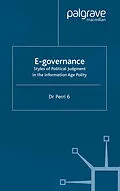The e-governance revolution is said to be changing everything, but will all the modelling tools, electronic meeting management systems and online consultations really change political judgement in policy formation? Using case studies from local and federal government in the US and Europe, Perri 6 examines these claims and presents a new theory of how policymakers use and reject information and do and don't trust each other with information in using the new tools, before analyzing the implications for democracy.
Autorentext
PERRI 6 is a leading political scientist working on public policy and the policy process. Now a Senior Research Fellow in the Health Services Management Centre at the University of Birmingham, he was previously at King's College London, Strathclyde University and the think tank Demos. His jointly written book, Towards Holistic Governance, was published by Palgrave Macmillan in 2002.
Zusammenfassung
The e-governance revolution is said to be changing everything in the public sector. However, will all the modelling tools, electronic meeting management systems and online consultations really change political judgment in policy formulation? Using new case studies from local and national government in the USA, the UK and Europe, E-Governance examines these claims in detail. Perri 6 presents a distinctive account of what political judgment actually is, considered as an organisational process. He then presents a new theory of how policy-makers use and reject information and do and do not trust each other with information in using the new tools, before analysing the implications for democracy. The book concludes by identifying some practical ways forward for policy-makers.
Inhalt
Acknowledgements Introduction The Scope of E-Governance Examples and Initiatives The Forward March of E-Governance Halted? What Difference Could E-Governance Make? Fears, Aspirations and Theories Conducting Policy Judgement Through Information Technologies: Three Cases Policy Making: The Work of Governance The Organization of Policy Makers and the Use of E-Governance Tools Institutional Styles and E-Governance Tools Ways Forward Conclusion Notes References
